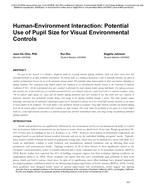Description
The goal of this research is to develop a diagnostic model for assessing ambient lighting conditions, which can detect visual stress and discomfort problems in an office workplace environment. The human body, as a biological mechanism, is able to naturally minimize any effects of ambient environmental stressors by use of the autonomic nervous system. This principle allows human pupils to dilate and contract, depending on lighting condition. This experiment using human subjects was conducted in an environmental chamber located at the University of Southern California (USC). All the experimental data were analyzed to determine the most common feature among individuals. One lighting parameter, light intensity, (lux or foot-candels (fc)) was controlled and maintained for each voluntary subject for a paper-based task in a simulated workplace setting. All the subjects’ pupil signals (i.e. sizes) and the ambient lighting parametric data were recorded in real time while their eye’s responses to luminance intensities were periodically recorded during each change in the lighting condition through a survey. This study provides unique knowledge concerning how an individual’s physiological signal can be translated to estimate his or her visual light intensity sensation, as one aspect of visual comfort in the workplace. The result defines a new qualitative measure of occupants’ visual light intensity sensation and optimal lighting levels for the human subjects involved while other variables are kept constant. This study shows the possibility of one aspect of a visual comfort model (i.e., visual light intensity sensation) as a function of pupil sizes and their standardized values, and energy savings via optimizing individuallighting conditions.
Citation: IAQ Conference: IAQ 2013: Environmental Health in Low Energy Buildings
Product Details
- Published:
- 2013
- Number of Pages:
- 5
- File Size:
- 1 file , 1.7 MB
- Product Code(s):
- D-2013IAQConf-62




